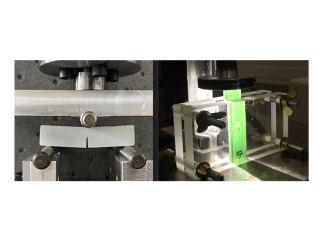A comparative study of DCDC and SENB tests for mode I fracture characterization of polymers
J. Diani & A. Coq
An elastic and an elastoplastic polymethyl methacrylate (PMMA), both in the glassy state, were characterized under mode I fracture using two experimental configurations: the single-edge notched bending (SENB) test and the double-cleavage drilled compression (DCDC) test. The fracture toughness of the elastic material was evaluated within the framework of linear elastic fracture mechanics (LEFM), whereas for the elastoplastic material, the J-integral was computed from full-field strain measurements when available.
Finite element simulations were conducted to perform complementary numerical analyses based on two damage modeling approaches: cohesive zone modeling and phase-field modeling. These simulations provided estimates of the critical energy release rate. Both modeling approaches produced comparable results; however, the phase-field model did not always predict the material toughness, owing to its sensitivity to the regularization parameter.
For both materials and testing configurations, the estimated critical energy release rates are consistent with values reported in the literature. Interestingly, for a given material, the two experimental methods yielded significantly different toughness estimates, highlighting the challenge engineers face when selecting an appropriate test for assessing mode I fracture properties.

